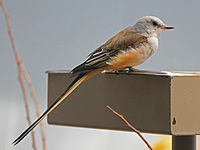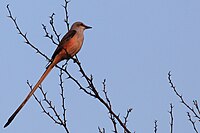Scissor-tailed flycatcher
| Scissor-tailed flycatcher | |
|---|---|

| |
| Scientific classification | |
| Domain: | Eukaryota |
| Kingdom: | Animalia |
| Phylum: | Chordata |
| Class: | Aves |
| Order: | Passeriformes |
| Family: | Tyrannidae |
| Genus: | Tyrannus |
| Species: | T. forficatus
|
| Binomial name | |
| Tyrannus forficatus (Gmelin, JF,1789)
| |

| |
Breeding Migration Nonbreeding
| |
| Synonyms | |
|
Muscivora forficata | |
Thescissor-tailed flycatcher(Tyrannus forficatus), known asswallow-tailed flycatcherorscissorstail,is a long-tailedinsectivorousbird of thegenusTyrannus,whose members are collectively referred to askingbirds.Its scientific name used to be Muscivora forficata until it was changed to Tyrannus forficatus. It is found inNorthandCentral America,and is Oklahoma's State Bird.
Taxonomy
[edit]The scissor-tailed flycatcher wasformally describedin 1789 by the German naturalistJohann Friedrich Gmelinin his revised and expanded edition ofCarl Linnaeus'sSystema Naturae.He placed it with the flycatchers in thegenusMuscicapaand coined thebinomial nameMuscicapa forficata.[2][3]The specific epithet is fromLatinforfex,forficismeaning "a pair of scissors".[4]Gmelin based his description on "Le moucherolle à queue fourchue du Mexique" (French:"theMexicanswallow-tailed flycatcher ") that had been described in 1778 by the French polymathComte de Buffonfrom a specimen from Mexico and illustrated with a hand-coloured engraving byFrançois-Nicolas Martinet.[5][6]The scissor-tailed flycatcher is now one of 13 species placed in the kingbird genusTyrannusthat was introduced in 1799 byBernard Germain de Lacépède.[7]The species ismonotypic:nosubspeciesare recognised.[7]
Within the genusTyrannus,the scissor-tailed flycatcher is most closely related to thewestern kingbird(Tyrannus verticalis).[8]In easternArkansasand westernTennessee,there is a hybrid breeding zone where the scissor-tailed flycatcher and the western kingbird are sympatric and possibly compete for the same niche.[9]Both these species have simultaneously expanded their breeding ranges eastward over the past 50 years.
Description
[edit]Adult birds have pale gray heads and upper parts, light underparts, salmon-pink flanks and undertailcoverts,and dark gray wings. Axillars and patch on underwing coverts are red.[10]Their extremely long, forked tails, which are black on top and white on the underside, are characteristic and unmistakable. At maturity, the male may be up to 15 in (38 cm) in length, while the female's tail is up to 30% shorter. The wingspan is 15 cm (5.9 in) and the weight is up to 43 g (1.5 oz).[11]Immature birds are duller in color and have shorter tails. A lot of these birds have been reported to be more than 40 cm (16 in).[citation needed]
Breeding
[edit]They build a cup nest in isolated trees or shrubs, sometimes using artificial sites such astelephone polesnear towns. The male performs a spectacular aerial display during courtship with his long tail forks streaming out behind him. Both parents feed the young. Like other kingbirds, they are very aggressive in defending theirnest.Clutches contain three to sixeggs.
Diet
[edit]In the summer, scissor-tailed flycatchers feed mainly on insects (grasshoppers,robber-flies,anddragonflies), which they may catch by waiting on a perch and then flying out to catch them in flight (hawking). For additional food in the winter they will also eat someberries.
Distribution and habitat
[edit]Their breeding habitat is open shrubby country with scattered trees in the south-central states ofTexas,Oklahoma,Kansas,western portions ofLouisiana,Arkansas, andMissouriwest to far easternNew Mexicoand northeastern Mexico. Reported sightings record occasional stray visitors as far north as southernCanadaandUpstateNew York,as far east asFloridaandGeorgia,and in theWest Indies.Theymigratethrough Texas and eastern Mexico to their winter non-breeding range, from southern Mexico toPanama.Pre-migratory roosts and flocks flying south may contain as many as 1000 birds.[12]
In culture
[edit]
The scissor-tailed flycatcher is thestate birdofOklahoma,and is displayed in flight with tail feathers spread on the reverse of theOklahoma Commemorative Quarter.
Professional soccer teamFC Tulsafeatures a scissor-tailed flycatcher on their crest. The scissor-tailed flycatcher is also displayed in the background of the current license plate.
The bird is featured on the box of the popular 2019 board gameWingspan.
A scissor-tailed flycatcher named MC Sizzy is featured in the 2015National Geographic KidsTV show50 Birds, 50 States.
Gallery
[edit]-
At the National Aviary
-
At the National Aviary
-
NearTampico,Mexico
References
[edit]- ^BirdLife International (2021)."Tyrannus forficatus".IUCN Red List of Threatened Species.2021:e.T22700500A137915793.doi:10.2305/IUCN.UK.2021-3.RLTS.T22700500A137915793.en.Retrieved11 November2021.
- ^Gmelin, Johann Friedrich(1789).Systema naturae per regna tria naturae: secundum classes, ordines, genera, species, cum characteribus, differentiis, synonymis, locis(in Latin). Vol. 1, Part 2 (13th ed.). Lipsiae [Leipzig]: Georg. Emanuel. Beer. p. 931.
- ^Traylor, Melvin A. Jr, ed. (1979).Check-List of Birds of the World.Vol. 8. Cambridge, Massachusetts: Museum of Comparative Zoology. p. 225.
- ^Jobling, James A. (2010).The Helm Dictionary of Scientific Bird Names.London: Christopher Helm. p. 162.ISBN978-1-4081-2501-4.
- ^Buffon, Georges-Louis Leclerc de(1778)."Le moucherolle à queue fourchue du Mexique".Histoire Naturelle des Oiseaux(in French). Vol. 4. Paris: De l'Imprimerie Royale. pp. 564–565.
- ^Buffon, Georges-Louis Leclerc de;Martinet, François-Nicolas;Daubenton, Edme-Louis;Daubenton, Louis-Jean-Marie(1765–1783)."Gobe-mouche à queue fourchue, du Mexique".Planches Enluminées D'Histoire Naturelle.Vol. 7. Paris: De L'Imprimerie Royale. Plate 677.
- ^abGill, Frank;Donsker, David;Rasmussen, Pamela,eds. (January 2023)."Tyrant flycatchers".IOC World Bird List Version 13.1.International Ornithologists' Union.Retrieved20 March2023.
- ^Harvey, M.G.; et al. (2020). "The evolution of a tropical biodiversity hotspot".Science.370(6522): 1343–1348.doi:10.1126/science.aaz6970.hdl:10138/329703.PMID33303617.A high resolution version of the phylogenetic tree in Figure 1 is available from the first author's websitehere.
- ^Worm, J.R.; Roeder, D.V.; Husak, M.S.; Fluker, B.L.; Boves, T.J. (2019). "Characterizing patterns of introgressive hybridization between two species of Tyrannus following concurrent range expansion".Ibis.161(4): 770–780.doi:10.1111/ibi.12674.
- ^Godfrey, W. Earl (1966).The Birds of Canada.Ottawa: National Museum of Canada. p. 250.
- ^Sibley, David Allen(2000).The Sibley Guide to Birds.New York: Knopf. p.338.ISBN0-679-45122-6.
- ^"Scissor-tailed Flycatcher".All About Birds.Cornell Lab of Ornithology.
External links
[edit]- "Tyrannus forficatus".Avibase.
- Scissor-tailed flycatcher -Tyrannus forficatus- USGS Patuxent Bird Identification InfoCenter
- Stamps[usurped]forEl Salvador,Nicaragua,United Statesat bird-stamps.org
- Scissor-tailed flycatcher photo galleryat VIREO (Drexel University)
- "Scissor-tailed flycatcher media".Internet Bird Collection.
- Birds of Oklahoma: Scissor-tailed Flycatcher, Oklahoma's State Bird(with link to image gallery)
- Scissor-tailed flycatcher species accountat Neotropical Birds (Cornell Lab of Ornithology)
- Interactive range map ofTyrannus forficatusatIUCN Red List maps





